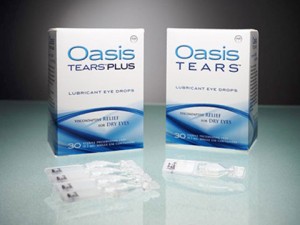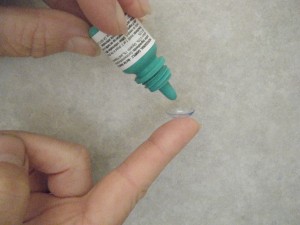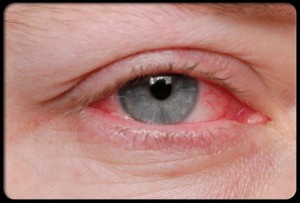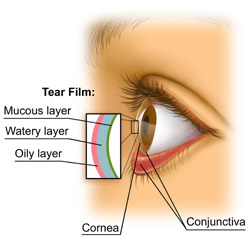A common complaint I hear is “my eyes burn and water.” Meibomian Gland Dysfunction is a common, chronic condition and is usually the cause of the discomfort. MGD occurs when the opening to the meibomian gland is plugged. The openings to the glands are at the edge of the eyelid margins, near the base of the eyelashes. The blockage can be caused by make-up, lotions, and sunscreens that plug the opening. Other factors are usually involved too. For example, skin conditions such as acne rosacea are a common cause of MGD. Age, sex, hormonal disturbances, allergies and certain medications negatively affect the glands too.
The treatment depends on the severity of the condition. Hot compresses and eyelid hygiene is always recommended. Dietary modifications, inclusion of omega-3 fatty acids and hydration are beneficial. For more advanced cases, topical and/or oral medications may be required to control MGD.
If left untreated, the glands will thicken and scar causing chronic dry eye signs and symptoms and more discomfort.
Category: Dry Eyes
Wintertime Dry Eyes
Winter winds and moisture zapping heaters can cause dry, red and irritated eyes.
Tears are essential for good eye health and clear vision. They bathe the eye, washing out dust and debris, and  keep the surface moist and clear. The natural tear film also contains enzymes that neutralize microorganisms, reducing the risk of eye infections.
keep the surface moist and clear. The natural tear film also contains enzymes that neutralize microorganisms, reducing the risk of eye infections.
The most common signs and symptoms of dry eyes are persistent dryness and irritation, scratchiness, a burning feeling in your eyes and red eyes. Oddly enough, dry eye syndrome also can make your eyes watery, as dryness can cause a protective overproduction of the watery component of your tears.
How to prevent dry eyes in winter
Cold winter wind outdoors and dry heat indoors can cause or worsen dry eyes. Follow these tips to keep dry eyes at bay.
- Wear sunglasses or goggles. Wearing close-fitting sunglasses outdoors reduces exposure to sun and wind that can dry out your eyes. If it’s especially cold and windy, try foam-lined goggles that provide even greater protection from tear evaporation.
- Supplement your diet. Fish oil and other nutritional supplements containing omega-3 fatty acids can help prevent or relieve dry eye symptoms.
- Drink more water. Mild dehydration often makes dry eyes worse, especially during dry and windy weather.
- Switch contact lenses. If your contact lenses feel dry and uncomfortable, ask me about trying different lenses that are replaced more frequently and/or are better for someone with dry eyes.
Dry eyes may not be completely curable in certain cases, but the unpleasant dryness, scratchiness and burning sensation can be managed. We are carrying a new artificial tear called Oasis that contains long-molecule hyaluronic acid which keeps the moisture on the eye longer. Click here to read more about dry eye syndrome.
Long-Lasting Lubricating Eye Drop
Not all eye drops are the same. Oasis TEARS is a new type of eye drop with a unique formula, optimized to provide long-lasting comfort. Some of the benefits of Oasis TEARS Lubricant Eye Drops:
- Oasis TEARS offers instant relief of dry eye symptoms
- It is natural and contains no damaging chemicals
- Provides prolonged comfort with fewer applications
- Provides moistening and lubrication to the surface of the eye
- Eliminates the source of toxic irritation with preservative-free options
Oasis TEARS Lubricant Eye Drops coat, lubricate, and moisten delicate eye tissue. With each blink of your eye, a special substance in Oasis TEARS combines with the active ingredient, glycerin, to keep tears on the eye surface for a long time. This unique combination coats and recoats the surface of the eye for continued relief of dry and, irritated eyes. Use Oasis TEARS to relieve all dry eye symptoms any time of day. They work well for tired eye and discomfort related to computer vision syndrome.
Westside Optometry is pleased to offer Oasis TEARS for dry eye relief. To learn more about Oasis TEARS click here
Contact Lens Tip
An easy way to make contact lenses more comfortable is to put a drop of artificial tears into the eye or onto the lens before putting on the contact lens. The scientific basis for this includes physical lubrication which enhances comfort by reducing dryness and protecting the cornea (surface of the eye). It also increases viscosity and lowers the tear film tension so the eye stays wetter.
In addition, the common ingredient in artificial tears is carboxymethylcellulose (CMC). The CMC is negatively charged so it binds to the preservatives in the multi-purpose disinfecting solutions to decrease irritation.
If your contact lenses are uncomfortable and you find yourself taking the lenses out earlier each day or not even putting them in, call Westside Optometry to schedule an appointment.
Burning Eyes
Red rimmed eyes, burning eyes, watery eyes. These are symptoms of eyelid inflammation caused from Meibomian gland dysfunction (MGD), blepharitis or both. Another condition of the eyelid that causes discomfort and redness are styes; when one of the eyelid glands becomes infected. Styes are more localized and found on the edge if the eyelid.
The Meibomian glands are between the eyelashes. They can become plugged and inflamed causing problems with the tear quality. The compromised tears evaporate quickly causing the lacrimal gland to overcompensate and produce too many tears which spill over the eyelids. The inflammation produces a foamy discharge that sits on the lower eyelid margin causing irritation and burning.
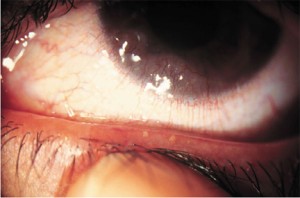
Blepharitis in an infection or irritation of the eyelid. The typical sign of “bleph” is flakes and/or debris on the eyelashes. The flakes and debris end up in the eye causing irritation and redness.
At night when we sleep, the eye is closed and not blinking. Tear production is greatly reduced. Anything left on the eyelashes and eyelids will sit on the eye all night causing discomfort, grittiness and redness by morning. Treatment involves removing the potential irritants. This includes thorough removal of make-up and creams. A hot compress will soften the waxy plugs in the meibomian glands. Mild cleaning solution and a washcloth or cotton swab will remove debris from the eyelids and eyelashes. For a printable description of eyelid hygiene click here.
Good lid hygeine will improve contact lens comfort during the day, and reduce dry eye symptoms too.
Why is Driving at Night so much harder than Driving during the Daytime?

Even with the longer days of spring, driving at night is still challenging.
When you are behind the wheel of a car, your eyes are constantly on the move – looking at vehicles ahead and to the side, reading traffic signs, checking your rear view mirror, and shifting your gaze inside and outside your vehicle in order to check the speedometer, look at your global navigation system, or change a radio station.
During darkness these tasks can become even more difficult for some drivers. According to a nationwide survey 32% of the drivers say they have difficulty seeing all or most of the time while driving in the dark.
Low light levels cause the pupil to dilate, which can accentuate existing focusing problems and result in blurred vision. Wearing the best distance correction will minimize this vision problem. At Westside Optometry we also recommend a non-glare coating to eliminate reflections from annoying headlights.
Dry eyes will effect your vision when driving at night also. If the tear layer is uneven, thick or thin, the quality of vision is negatively impacted. I compare this phenomena to the windshield and wipers. Every blink is like the windshield wiper across the windshield, in the case of the eye, the eyelid wipes across the cornea. If the windshield is dry, the wiper makes it smeary. You can resolve this by squirting water on the windshield and wiping again. If the eye is dry, vision gets smeary and sometimes there are not any tears to clear it up. I recommend applying a drop of artificial tear solution before starting to drive at night.
When you do not see well you have to get closer or drive slower, and if you do not account for that need, you are at risk of causing accidents.
Eye Allergies

Driving through the Sonoma wine country last weekend, I thought how lucky I am to live in such a beautiful place. The fields were green, the lambs were frolicking and the mustard was in full bloom. Gorgeous! But if you suffer from allergies, Sonoma County can be wicked to your eyes and sinuses. Petaluma tends to be particularly windy, stirring up the pollen even more.
Eye allergies are also called “allergic conjunctivitis.” It is a reaction to indoor and outdoor allergens (such as pollen, mold, dust mites or pet dander) that get into your eyes and cause inflammation of the conjunctiva, the white tissue that lines the inside of the eyelid and eyeball. Eye allergies are not contagious.
Other substances called “irritants” (such as dirt, smoke, chlorine, etc.) and even viruses and bacteria, can compound the effect of eye allergies, or even cause irritating symptoms similar to eye allergies for people who are not even allergic. The eyes are an easy target for allergens and irritants because like the skin , they are exposed and sensitive. Dry eyes tend to be more susceptible to ocular allergies because there are less tears to rinse allergens and irritants away.
Certain medications and cosmetics can also cause eye allergy symptoms. By way of response to these allergens and irritants, the body releases chemicals called histamines, which in turn causes inflammation. This reaction makes the eye tissues red and swollen.
The signs of eye allergies are red, itchy, burning, tearing, swollen eyes, along with a gritty sensation. These symptoms may be accompanied by a runny or itchy nose, sneezing, coughing, or a sinus headache. Many sufferers also find that their vision is temporarily blurred.
I find it best to treat eye allergies before the onset of symptoms, but treatment can improve comfort and the appearance of the eye anytime. Do not suffer, there are treatments to control eye allergies.
What to Expect from your Eyes when Expecting
During pregnancy a woman’s body undergoes miraculous changes, some good, some uncomfortable and some that are puzzling. Everyone experiences different things as every pregnancy is unique.
The eyes do not escape the wild hormonal ride during pregnancy. The lens and/or cornea respond to fluctuations in hormones. Not every pregnant woman will see vision changes but for those who do the impact is significant. Ocular structures swell and deswell causing refractive changes. The result of these changes is blurry vision. The women I have treated with vision changes notice shifts in their vision for most of their pregnancy. Some woman experience increased dry eye and/or contact lens intolerance.
The good news is I can usually help patients through their pregnancy with temporary vision corrections. And the best news is that most symptoms resolve post-partum.
Another ocular concern during pregnancy is the exacerbation of pre-existing conditions such as Graves disease and diabetes. Although these are systemic diseases, they have significant effects on the eye health.
2012 New Years Resolutions
If you make your 2012 resolutions with the intention of achieving good health and well-being, you will be benefiting your eyes also. Here are recommendations from Westside Optometry to get you started:
1. QUIT SMOKING
Smoking contributes to cataract formation, macular degeneration and dry eyes.
2. EAT MORE FRUITS AND VEGETABLES
Anti-oxidants and other nutrients found in a variety of fruits and vegetables can prevent age-related ocular conditions such as cataracts and macular degeneration.
3. EXERCISE REGULARLY
Exercise can benefit you in many ways. It reduces stress, helps control weight and improves circulation all benefits for you and your eyes.
4. SCHEDULE EYE EXAMINATIONS FOR THE KIDS
It is never to early for children to have their eyes examined. The American Optometric Association recommends the first eye exam at 6 months of age. Early detection of vision problems can save your child much frustration when learning to read and play sports.
Happy New Year
Dry Eye Symptoms and Treatments
Last time I talked about the risks of dry eye. This included the increase incidence for people with diabetes. Today let’s talk about the symptoms. Dry eye presents in many different ways: the eyes can sting, burn, feel gritty, scratchy and even watery. That’s right, you can suffer from dry eyes and produce too many tears. The other significant symptom of dry eyes is fluctuating vision. If the tears evaporate too quickly, vision is best right after a good blink and blurs until the next blink. Identifying which layer or layers are compromised is the first step to finding the right treatment.
The tears consist of 3 different components:
1. Oils or lipids from the meibomian glands (in the eyelid)
2. Mucus from the goblet cells (surface of the eye)
3. Water or aqueous from the lacrimal gland (under the brow)
The eyelid can be a problem too. Inflammation of the eyelid margin is often a factor. The eyelid changes with age, it may be scarred or looser causing the lid to turn inward or outward. Either direction has a negative effect on the tears and blinking.
The goal of dry eye treatment is to restore the tear film balance. Addition of a humidifer, drops, ointments, supplements, change in diet, and/or punctal plugs can all be helpful. Once the cause of dry eye disease is identified I can create a treatment plan.
The first thing I recommend in treating dry eye disease is to control the factors that you can. Check out the last blog for a list, you can’t change your age or gender, but you can control your blood sugar, and some environmental factors. What you eat or do not eat matters too. Too much caffeine will dehydrate you. If you are a fan of energy drinks that are high in caffeine and sugar, try a week or two without them and see if your eyes feel better. I’ve seen significant improved in contact lens tolerance with the elimination of these drinks.
Do not suffer from dry eye, call Westside Optometry for evaluation and treatment. For more dry eye information download http://old.westsideoptometrynow.com/wp-content/uploads/2010/05/Dry-Eye-Syndrome.pdf
